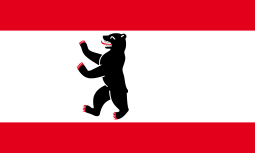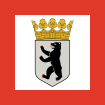Flag of Berlin
 | |
| Landesflagge (state flag) | |
| Use | Civil flag and ensign |
|---|---|
| Proportion | 3:5 |
| Adopted | 1954 (West); 1990 (Whole) |
| Design | A tricolor of red-white-red, defaced with an emblem. |
| Landesdienstflagge (state service flag) | |
 | |
| Use | State flag and ensign |
| Proportion | 3:5 |
| Adopted | 1954 (West); 1990 (Whole) |
| Standard of the Berlin Senate | |
 | |
| Use | State flag |
| Proportion | 1:1 |
| Adopted | 1990 |
The flag of Berlin has three stripes of red-white-red, the two outer stripes each occupying a fifth of its height, the middle the remaining three fifths. It is emblazoned with a bear on the civil flag, while it bears the coat of arms of Berlin on the state flag.
The civil flag of West Berlin was adopted on 26 May 1954. Designed by Ottfried Neubecker, it came in second in the contest of 1952, the winner being rejected by the Senate. The bear is placed slightly off-center toward the left.
A bear occurs on seals, coins and signet rings from as early as the late 12th century (but not as heraldic charge before 1709), presumably due to a canting association with the city's name.[1]
The state flag replaces the bear with the full coat of arms, with the bear inside the escutcheon. Being the state flag for West Berlin, it became the flag of the entire city after the reunification of Germany in 1990.[2] Prior to that, it had also been the naval ensign as no other existing flag could be used. The proportions of the flag are 3:5.[3]
Historical flags
Between 1618 and 1861 a bicolour of black over white was used as both a civil and state flag, under Brandenburg and successive Prussian rules.
Between 1861 and 1912, a horizontal tricolour of black, red and white was used in the proportions of 2:3. It was designed by Ernst Fidicin based in the Brandenburg colors following the coronation of Wilhelm I on 19 December 1861.
Between 1913 and 1954, the civil flag was similar to the current one, except the design of the bear was different. Until 1935, the emblem itself was not established.
From 1955 on, East Berlin had the addition of two white stripes taking the outside halves of the upper and lower red stripes, and a slightly different design for the bear inside an escutcheon, topped with a crown.[4] The East Berlin flag was therefore a slightly modified version of the old state flag, with the civil flag being deliberately avoided in East Berlin—and conversely, adopted as official in West Berlin—due to the bear in the civil flag being off-center to the left and facing left, strongly suggesting an orientation toward the West. The West Berlin flag was adopted for all of Berlin after 1990.
See also
- Berolina, personification of Berlin
References
- ^ Konrad Berlin, "Berliner Bär und Mäuseturm", Muttersprache 1958, pp. 271-273. The name Berlin is of Slavic origin and unrelated to the word bear, but the area was settled by German speakers from as early as the 12th century. Reinhard E. Fischer: Die Ortsnamen der Länder Brandenburg und Berlin. Alter – Herkunft – Bedeutung. be.bra wissenschaft verlag, Berlin-Brandenburg 2005, ISBN 3-937233-30-X, S. 25.
- ^ Birgit Laitenberger; Maria Bassier (2000), Wappen und Flaggen der Bundesrepublik Deutschland und ihrer Länder: Allgemeine Einführung (Coats-of-arms and flags of the Federal Republic of Germany and her states: General introduction in state symbols) (in German)
{{citation}}: CS1 maint: multiple names: authors list (link) - ^ State Chancellery (1954), Gesetz über die Hoheitszeichen des Landes Berlin vom 13. Mai 1954 (Law on the State Symbols of the State of Berlin of 13th May 1954) (in German)
- ^ Klemens Stadler (1966), Deutsche Wappen. Bundesrepublik Deutschland: Die Gemeindewappen von Rheinland-Pfalz und Saarland, Bremen, Hamburg, Westberlin. (German Coats-of-Arms. Federal Republic of Germany: Municipal Coats-of-Arms of Rhineland-Palatinate, Saar, Bremen, Hamburg, West Berlin.) (in German)





